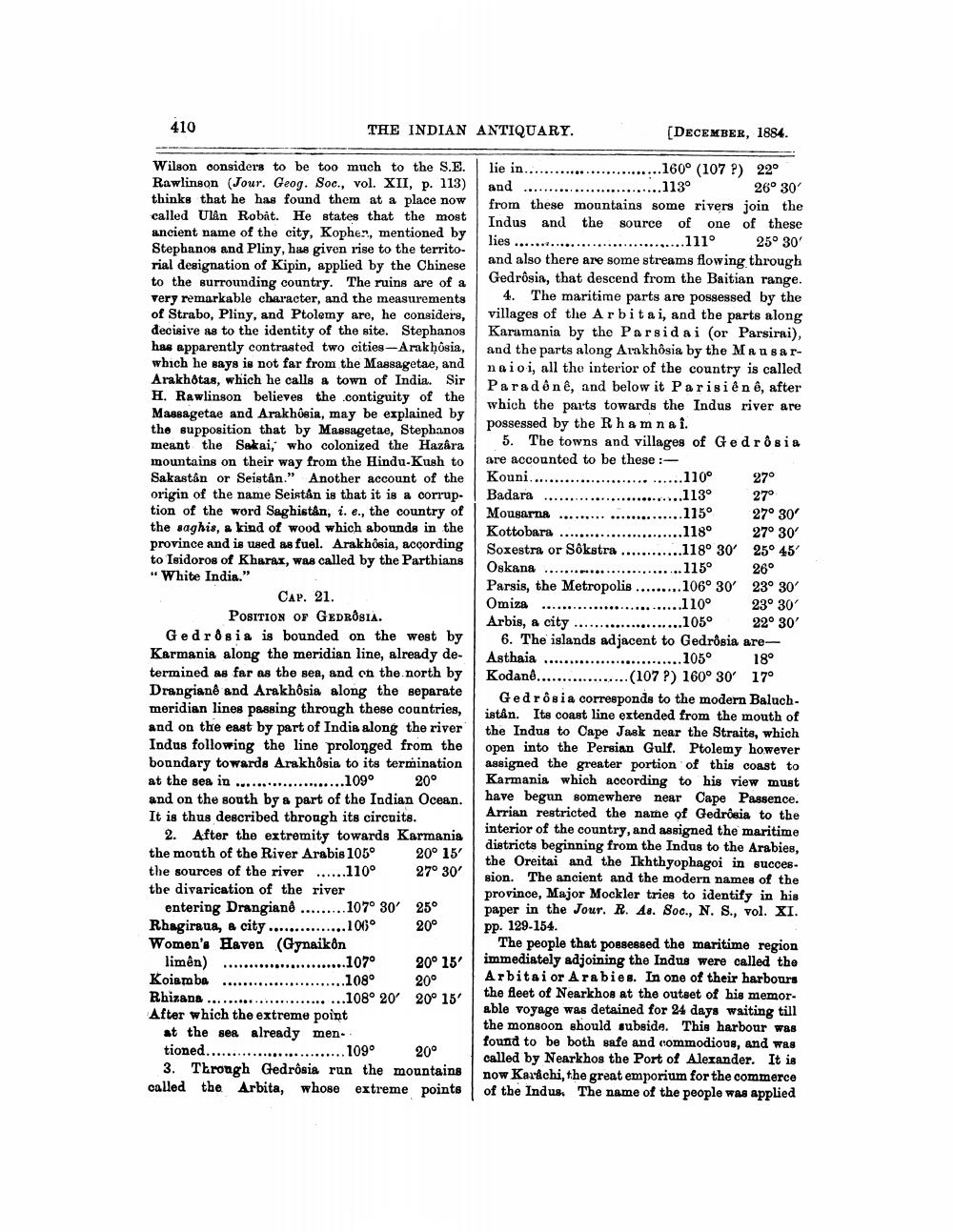________________
410
THE INDIAN ANTIQUARY.
[DECEMBER, 1884.
lies...
.....
Wilson considers to be too much to the S.
E Rawlinson (Jour. Geog. Soc., vol. XII, p. 113) thinks that he has found them at a place now called Ulân Robåt. He states that the most ancient name of the city, Kophe., mentioned by Stephanos and Pliny, has given rise to the territorial designation of Kipin, applied by the Chinese to the surrounding country. The ruins are of a very remarkable character, and the measurements of Strabo, Pliny, and Ptolemy are, he considers, decisive as to the identity of the site. Stephanog has apparently contrasted two cities---Arakhosia, which he says is not far from the Massagetae, and Arakhotas, which he calls a town of India. Sir H. Rawlinson believes the contiguity of the Massagetae and Arakhỏsia, may be explained by the supposition that by Massagetae, Stephanos meant the Sakai, who colonized the Hazara mountains on their way from the Hindu Kush to Sakastan or Seistån." Another account of the origin of the name Seistân is that it is a corrup. tion of the word Saghistån, i. e., the country of the saghis, a kind of wood which abounds in the province and is used as fuel. Arakhosia, according to Isidoros of Kharax, was called by the Parthians "White India."
CAP. 21.
POSITION OF GEDRÔSIA. Gedrðsia is bounded on the west by Karmania along the meridian line, already de- termined as far as the sea, and on the north by Drangianê and Arakhôsia along the separate meridian lines passing through these countries, and on the east by part of India along the river Indus following the line prolonged from the boundary towards Arakhðsia to its termination at the sea in .....................109° 20° and on the south by a part of the Indian Ocean. It is thus described through its circuits.
2. After the extremity towards Karmania the mouth of the River Arabis 105° 20° 15' the sources of the river ......110° 27° 30 the divarication of the river
entering Drangianê .........107° 30' 250 Rhagiraua, a city ............... 100° 20° Women's Haven (Gynaikon limên) ........
...............1070 20° 15' Koiamba
20° ........................108° Rhizana ..........................108° 20° 20° 15' After which the extreme point
at the sea already mentioned........................... 109° 20°
3. Trongh Gedrôsia run the mountains called the Arbita, whose extreme points
l ie in........... lie in..........................160° (107) 22° and ........... .............113° 26° 30' from these mountains some rivers join the Indus and the source of one of these
...........111° 25° 30' and also there are some streams flowing through Gedrôsin, that descend from the Baitian range.
4. The maritime parts are possessed by the villages of the Arbitai, and the parts along Karamania by the Parsidai (or Parsirai), and the parts along Arakhosia by the Mausarnaioi, all the interior of the country is called Paradê nê, and below it Parisien ê, after which the parts towards the Indus river are possessed by the Rhamna i.
5. The towns and villages of Gedrôsia are accounted to be these :Kouni..............
........110° 27° Badara ...........................113° 27° Mousarna ......................110 27° 30'
.........118° 27° 30 Soxestra or Sókstra ............118° 30' 25° 45 Oskana ..........
.........115 26° Parsis, the Metropolis ......... 106° 30' 23° 30' Omiza ............
........110° 23° 30' Arbis, a city ............
22° 30' 6. The islands adjacent to Gedrðsia areAsthaia ....... .............105° 18° Kodanê..................(107?) 160° 30' 17°
Gedrônia corresponds to the modern Baluch. istân. Its coast line extended from the mouth of the Indus to Cape Jask near the Straits, which open into the Persian Gulf. Ptolemy however assigned the greater portion of this coast to Karmania which according to his view must have begun somewhere near Cape Passence. Arrian restricted the name of Gedrosia to the interior of the country, and assigned the maritime districts beginning from the Indus to the Arabies, the Oreitai and the Ikhthyophagoi in succession. The ancient and the modern names of the province, Major Mockler tries to identify in his paper in the Jour. R. As. Soc., N. S., vol. XI. pp. 129-154
The people that possessed the maritime region immediately adjoining the Indus were called the Arbitai or Arabies. In one of their harbours the fleet of Nearkhos at the outset of his memorable voyage was detained for 24 days waiting till the monsoon should subside. This harbour was found to be both safe and commodious, and was called by Nearkhos the Port of Alexander. It is now Kardchi, the great emporium for the commerce of the Indus. The name of the people was applied




